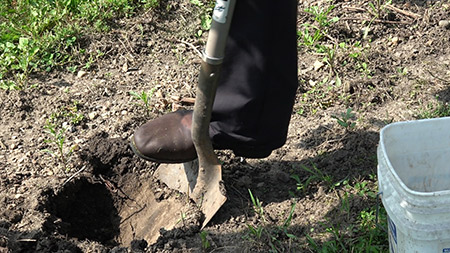
The content of this article 'Tissue and soil nutrient testing for cold climate grapes' was prepared by The University of Minnesota Extension and has been revised and republished by FreshFruitPortal.com.
For the latest information, check the University of Minnesota's website here.
There are 14 essential plant nutrients derived from the soil that are considered essential for the growth of all plants.
These are divided into six macronutrients: nitrogen (N), phosphorus (P), potassium (K), calcium (Ca), magnesium (Mg) and sulfur (S), and eight micronutrients: iron (Fe), manganese (Mn), zinc (Zn), copper (Cu), boron (B), molybdenum (Mo), chlorine (Cl) and nickel (Ni).
If any one of these nutrients is deficient in the vines, it can negatively affect grape yield and quality. When the soil cannot supply enough of each nutrient for adequate growth, you need to apply supplemental fertilizer.
There are two major tools to determine the fertilizer needs of a vineyard: tissue testing and soil testing. The need to supply fertilizer is also based on a number of factors including vine vigor and visual symptoms on the leaves.
Cold climate grapes often need fertilizer to provide the optimal levels and balance of nutrients for plant growth. But fertilizer cannot make up for poor insect and disease control, or correct problems like severe winter injury.
Tissue testing (sometimes called tissue analysis or foliar analysis) refers to a set of laboratory tests that measures the concentration of several key nutrients in a grapevine’s leaf tissue.
Tissue testing is based on these facts:
If the level of a nutrient falls outside of its optimum range, corrective measures should be taken, such as applying fertilizer or raising or lowering the soil pH with lime or sulfur, respectively.
Soil testing measures the soil pH, organic matter percentage (OM%) and the concentration of key nutrients such as phosphorus, potassium, magnesium, boron and micronutrients.
Conduct a soil test in the year before planting a new vineyard. This allows time to amend the soil and apply fertilizer before planting the vineyard. It is easiest to incorporate fertilizer before planting.
Once the vineyard is planted, it becomes more difficult to alter soil pH and levels of many nutrients because it will not be possible to incorporate fertilizer more than a couple of inches deep without damaging the vine roots.
Soil testing is also recommended every three to five years for established vineyards, to supplement tissue test interpretations.
Both tissue testing and soil testing serve important purposes in grape production. Soil tests show the nutrient, pH, and organic matter levels in the soil. Tissue tests show the actual nutrient status of the grapevines; in other words, how much of each essential nutrient that the plants take up.
Tissue tests should be conducted at least once per year to check the nutrient status of the grapevines. This can take place at bloom, veraison, or both.
Soil tests, on the other hand, should be used prior to planting to determine the organic matter and pH levels, lime requirements, as well as phosphorus, potassium, magnesium and micronutrient needs of the soil. They should also be conducted any time after significant soil amendments are applied, in order to measure their effect on soil chemical properties. In established vineyards, soil tests are primarily used as a supplement to tissue analysis information and should be done every three to five years.